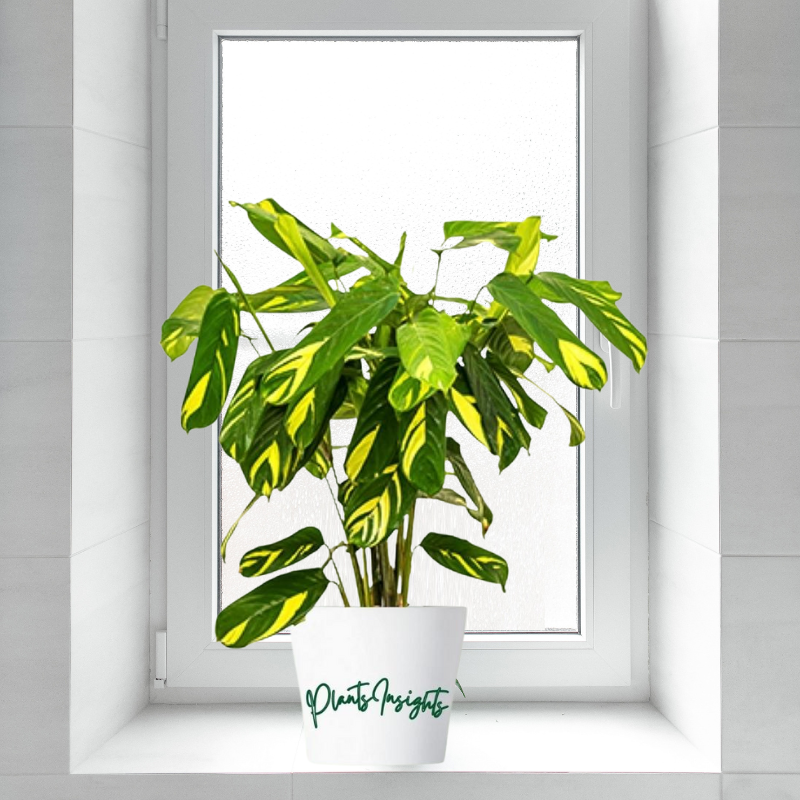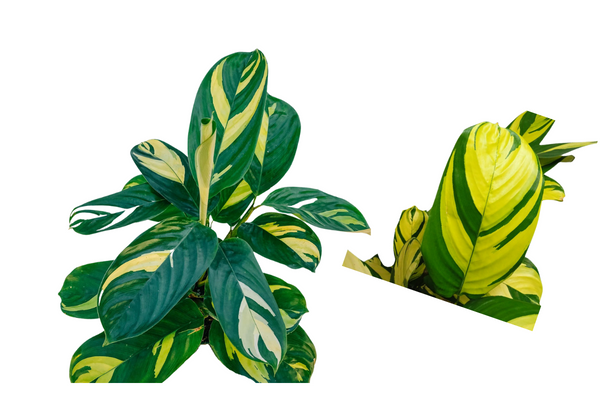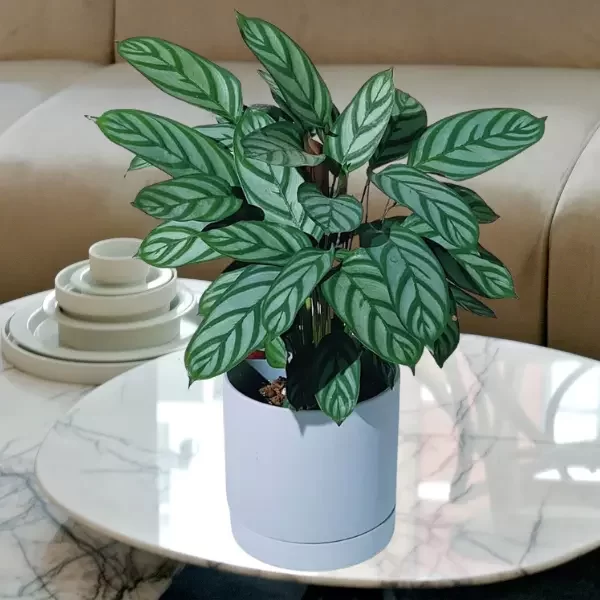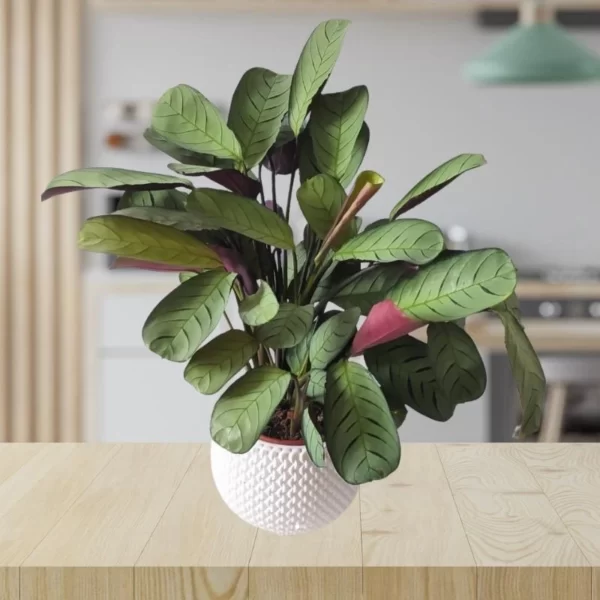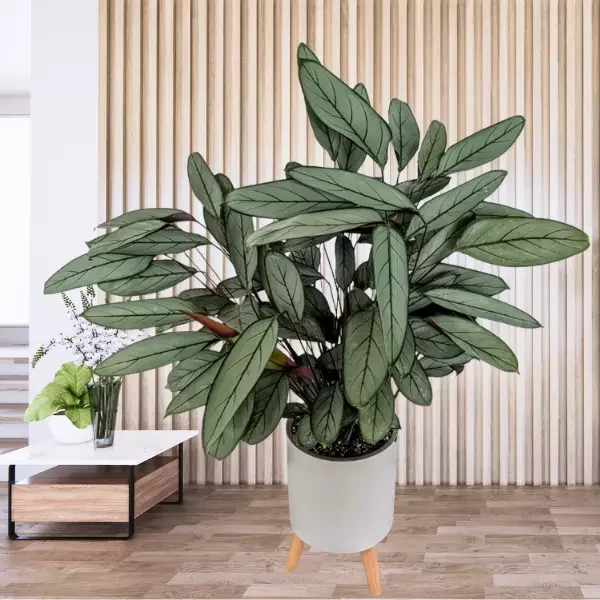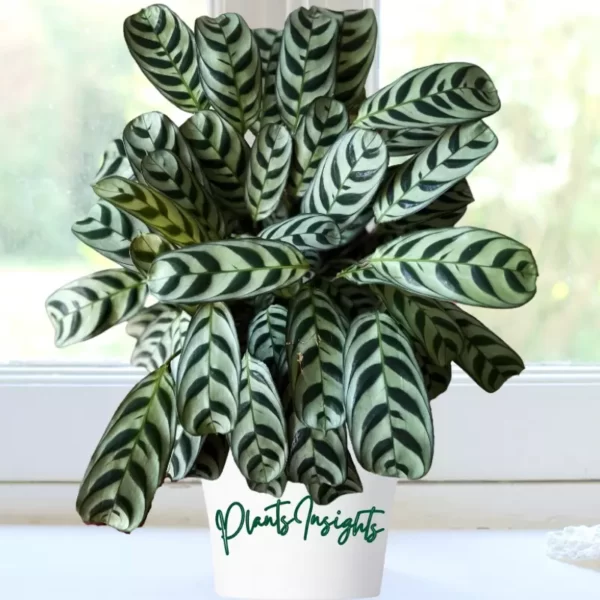Ctenanthe Lubbersiana, a member of the Marantaceae family, is renowned for its beautiful ovate foliage. The foliage is deep green and is covered with golden venations that break up the green colour. The stunning combination of the pattern and colours creates a beautiful look. One look at the gorgeous foliage of Ctenanthe Lubbersiana, and you will fall in love with this beauty.
This plant is much more than an ornamental piece; additionally, it has anti-pollutant characteristics that are great for areas that are not well ventilated in homes and offices. This plant is ideal if you want to breathe clean, fresh air indoors.
Like other prayer plants( Calatheas and Marantas) the long attractive leaves fold up at night, but its beautiful, variegated foliage will catch you during the day.
Allied Species: Ctenanthe Burle-Marxii, Ctenanthe oppenheimiana, Ctenanthe Setosa, Ctenanthe Marantifolia.
Related Products:
Habitat & Ecology
| Botanical Name: | Ctenanthe Lubbersiana’ Bamburanta’ |
| Family Name: | Marantaceae |
| Common names: | Bamburanta, Never Never plant , Golden Mosaic plant |
| Plant type: | Tropical perennial plant |
| Origin: | Central and South America |
| Height: | 3 feet tall |
| Humidity: | (50%-80%) Medium to high humidity |
| Temperature: | 60-80°F |
| Light Requirements: | Bright, indirect light |
| Growth Habit: | Clumping, Upright |
| Toxicity: | Kids and pets safe |
How do you care for Ctenanthe Lubbersiana?
Please consider the following critical aspects for Ctenanthe Lubbersiana’s optimal growth. You shall maintain high humidity, a good water supply, and avoid plant exposure to drafts and temperatures less than 60°F.
To keep your plants happy, pay close attention to the requirements and needs to flourish Bamburanta indoors.

Light requirement for Ctenanthe Golden Mosaic Plant
The Ctenanthe Lubbersiana grows under the tree canopies in their natural habitat, which means it is used to low light levels. The same lighting rules will apply when you bring one home as a houseplant.
The most recommended location for your plant is any South or West facing window for the entirety of the day. Make sure that the plant is not facing too much sun exposure. If the light levels are too strong, use a thin curtain as a barrier.
Low light levels can also severely affect the plant as it may cause the leaves to start losing their colour and pale. If you need to add some light levels, ensure that you provide at least 32 watts per square foot of non-natural light to complete your plant’s needs.

How often should I water Ctenanthe Lubbersiana?
The Golden Mosaic plant grows exceptionally well in a damp and humid environment. That is why you shall ensure that you water it regularly so the soil can remain moist. But make sure the soil doesn’t become waterlogged.
Water the plant only when the top of the soil is completely dry. You will generally water this plant 2-3 times in the summers, but in the winters, once a week will do the trick.
Make sure that you are watering the Ctenanthe with rain or soft water. Tap water contains chemicals that can damage your plant and cause the browning of the leaves.

Temperature and Humidity requirement
This plant has an ideal living temperature of around 60-80ºF. If the temperature exceeds or recedes from the ideal temperature, the plant will show signs of being under extreme stress. Make sure to keep your plant in the warmer range of the ideal temperature.
The Bamburanta plant does not like sudden temperature variations; therefore, please ensure to keep it away from places that give out cold/hot drafts like ACs, coolers, windows, and room heaters.
If you plan to grow this plant outdoors, don’t forget to bring it inside when the winters come in, and outside temperatures fall below 60ºF. The Ctenanthe cannot tolerate temperatures out of its ideal temperature zone and will show effects quickly.
As stated above, the plant is from rainforests; therefore, it is a specie that loves humid environments. Ctenanthe Lubbersiana requires a humidity level of 60% or more.
Moderate humidity levels are vital in keeping your Ctenanthe alive. However, to thrive, you must maintain a humidity-rich environment around the plant. You can use a hygrometer to monitor the humidity and temperature of plant’s surrounding.
A humidifier can help to provide the desired humidity, or you can place the plant at higher humidity locations in your home, such as a bathroom. You may provide the extra moisture to the plant by frequent misting; however, we do not recommend this practice as it takes more effort and can cause leaves fungal diseases. Please wipe clear the water from the leaves if doing so.
You can use a pebble tray filled with water to elevate the humidity levels if you are not planning to use a humidifier. You may also group your humidity-loving plants.
The edges of the leaves will start browning if the humidity levels are not taken care of.

Soil requirements
Ctenanthe Lubbersiana favours well-draining soil and can retain moisture for more extended periods. The moist soil is essential to ensure roots stay hydrated, and the draining capability ensures the roots are not sunk in excessive water.
Therefore, to achieve the desired properties for the soil, you need to develop a soil mix consisting of Coco Coir, Perlite and Orchid Bark to mimic the soil from tropical jungles. You may use readymade soil mix for tropical plants for a hassle-free solution.
The soil for Ctenanthe Bamburanta shall be slightly acidic. Ctenanthe absorbs the nutrients from the soil effectively if the Ph of the soil remains between 6 to 7. You can measure the soil’s pH level using a digital pH tester.

Fertilizer requirement of Ctenanthe lubbersiana
Ctenanthe Lubbersiana requires fertilization during the spring and summer growing seasons. A monthly application of diluted and balanced fertilizer will suffice to support lush growth. Please do not fertilize in the winter as the plant is naturally dormant at these times.
You can use a balanced general houseplant fertilizer for your Bamburanta. Please dilute the fertilizer to half strength before adding it to the soil. This diluted solution can be used at four-week intervals.
For the slow release of nutrients, it is a good idea to add aged compost to your soil mix when you are potting.

Repotting of Ctenanthe Lubbersiana
A happy and thriving Ctenanthe Lubbersiana shall be repotted once in two years. If you notice the plant is outgrowing its container, it requires repotting. We recommend repotting during early summer so the plant can recover from repotting stress during its growing period.
Please choose one size bigger pot as a new house for your Ctenanthe. To repot the plant, please remove the plant from the pot and shake off the existing soil. Snip the damaged or old roots and repot the plant in a new bigger pot in moist soil. Water the newly repotted plant. The roots become more resilient and fuller when they have access to sufficient air, water, and nutrients.
Ctenanthe Lubbersiana repotting can also be an excellent opportunity to divide the plant or remove offsets to propagate.

Pruning and maintenance of the Lubbersiana Ctenanthe
Ctenanthe Lubbersiana pruning is not complicated. Other than removing diseased, old, or dead leaves, it doesn’t need to be pruned regularly. This activity can be done as part of your regular maintenance.
With a sharp pruning shears, remove the dead leaves at the base. To keep the mother plant intact and manage the plant’s size, you may need to remove any offsets. Removing sick leaves and undesired offsets will redirect the energy to new growing younger leaves.
Disinfect your pruning shears and scissors when cutting Bamburanta to avoid fungal or bacterial infection. To prevent infections, make sure you make clean cuts.

How do you propagate Ctenanthe lubbersiana?
Golden Mosaic Ctenanthe propagation can be done through roots division or stem cutting. In root division, separate the offset from the primary plant roots by dividing the roots into different sections. Make sure that each root section has a few leaves with healthy stems.
Choose a healthy and mature stem if you use stem cuttings. You should ensure that the stem has healthy leaves. Cut it below the nodes, and either plant it in a growing medium ( potting mix)directly or place it in the water to let grow roots first, then transfer it into the pot to grow.
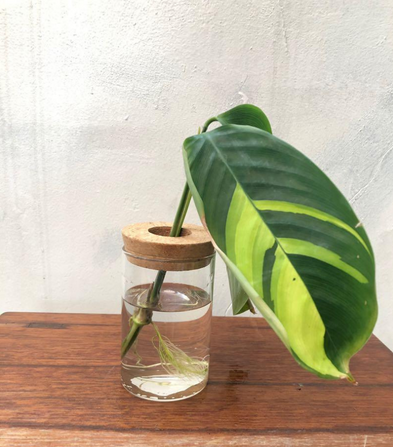
Ctenanthe Lubbersiana propagation generally is an easy task. The success rate is high.

Common Problems of Ctenanthe lubbersiana
Most of the Ctenanthe Lubbersiana issues you’ll encounter involve stress. This stress can be caused by poor growing conditions or the presence of pests and diseases. The following three common symptoms are observed that could result in minimal to severe damage.
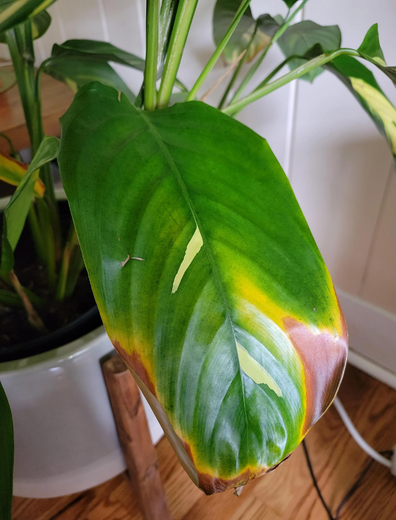
It is essential to properly diagnose the problem with Ctenanthe Lubbersiana, identify the root causes, and then find a solution. If necessary, adjust the required growing atmosphere around the plant.
Pests
Ctenanthe is home for mealy bugs as well as spider mites. They enjoy living on the leaf’s underside. The yellowing of the leaves can result from severe damage caused by pests.
The leaf surface must be examined closely to identify these organisms. The mealy bugs will appear as a powdery white colour, while the spider mites are tiny and make spider webs.
Ctenanthe Lubbersiana parasites can be controlled with insecticidal soap solution, alcohol, or neem oil.
Diseases
The most common diseases the Ctenanthe Lubbersiana can suffer from are southern blight, leaf spot disease, or root rot.
Southern blight and root rot are fungal diseases that develop in the soil. Symptoms are yellowing of lower leaves, lack of vigour, stem wilting and finally, the plant collapsing.
Please review your watering cycle to avoid over-watering the plant. In case of root rot, remove the plant from the existing pot, trim the diseased roots, repot the plant in fresh soil, and avoid over watering. You may apply a fungicide to the soil to treat the fungal diseases of soil.
The leaf spot disease results from an infestation attack on the plant or bacterial infection caused due to prolonged presence of water on leaves. In case of a pest attack, manually remove the pests from the plant and treat the plant with insecticidal soap, neem oil or a diluted solution of rubbing alcohol.
Always ensure the water does not stay on leaves for a more extended period. If you are misting your Ctenanthe plant, please ensure to wipe clean the leaves after misting.
Always use sterilized and disinfected gardening tools to prevent the spread of infection.

Toxicity of Ctenanthe Lubbersiana
According to the APSCA, this plant is not toxic to anyone. This plant has nothing toxic for humans and is easy and safe to handle. You can plant it in any area of your house, and it will not affect you or any pets in or near your house. Let’s not forget about children. However, some people have reported mild allergies caused by the plant.
For Humans
If you take care of your family’s health, you should consider buying the Ctenanthe Lubbersiana. Since all the plant parts are non-toxic, you shall not fret about anyone getting sick. But please be informed the plant is not eatable and shall not be consumed.
If you have children, warn them not to eat or digest the leaves. The plant may look beautiful on the outside, but they don’t have good taste in any sense. It may cause skin allergies and irritations to those who already have skin issues, so that is why you will need to stop them from eating the plant.
For Pets
Your Ctenanthe is also safe for pets. You can also plant them indoors, even if you have pets. It is non-toxic, so you don’t need to worry if your pet accidentally ingests the leaves.
There is a possibility of irritation if too many leaves are consumed. You should always be on guard for your pet if they are very sensitive.
Ctenanthe Lubbersiana Suggested Uses
Ctenanthe Lubbersiana is an ornamental plant that can be used in many ways. You can either plant it in pots or place it indoors. This will make your home more beautiful by creating a new, tropical look.
You can also plant it outside as ground cover, along sidewalks, or on the patio. You can add a splash to your garden with these colourful plants. It’s a perfect treat for those who pass by.
Ctenanthe offers many benefits beyond aesthetics, such as purification, stress reduction, fatigue, mood-boosting, and creativity. The therapeutic effects of this plant are well-known.
Related Posts
FAQS
Is Ctenanthe Lubbersiana a Calathea?
Ctenanthe Lubbersiana belongs to the Marantaceae family and is a close relative of Calathea. However, Ctenantheis a different genus from Calathea but belongs to the same family.
Is Ctenanthe Lubbersiana easy to care for?
Ctenanthe Lubbersiana is relatively easy to take care of and will happily thrive if you take care of surrounding conditions and watering. It is also easy to propagate this beauty.
All plants require the right amount of light, water, and nutrients to grow to their full potential. ‘Golden Mosaic’ a is no different. Since their natural habitat is rainforests of Central and South America, they love high humidity and moist soil and warm temperature. They sure will brighten up your place with their remarkable foliage.
Ctenanthe Setosa Compact Star | Never Never Plant Care Tips
Ctenanthe Setosa Compact star has many trade names such as Calathea Setosa, Never-Never plant or Prayer Plant.
Ctenanthe Burle Marxii Amagris | Never Never Plant Care
Ctenanthe (pronounced te-NANTH-ee) Setosa ‘Grey Star’ of the Marantaceae family is an attractive and vibrant plant.
Ctenanthe Setosa ‘Grey Star’ Care and Propagation Guide
Ctenanthe (pronounced te-NANTH-ee) Setosa ‘Grey Star’ of the Marantaceae family is an attractive and vibrant plant.
Ctenanthe Oppenheimiana | Giant Bamburanta Care Guide
Ctenanthe Oppenheimiana | Giant Bamburanta (Never Never Plant) is a bushy perennial plant found in tropical forests in Northeast Brazil.
Ctenanthe Burle-Marxii Amabilis “Fishbone Prayer Plant” Care
Ctenanthe Burle Marxii’s common name is The Fishbone Plant due to the interchanging patterns of dark green strokes that run along its midrib.


